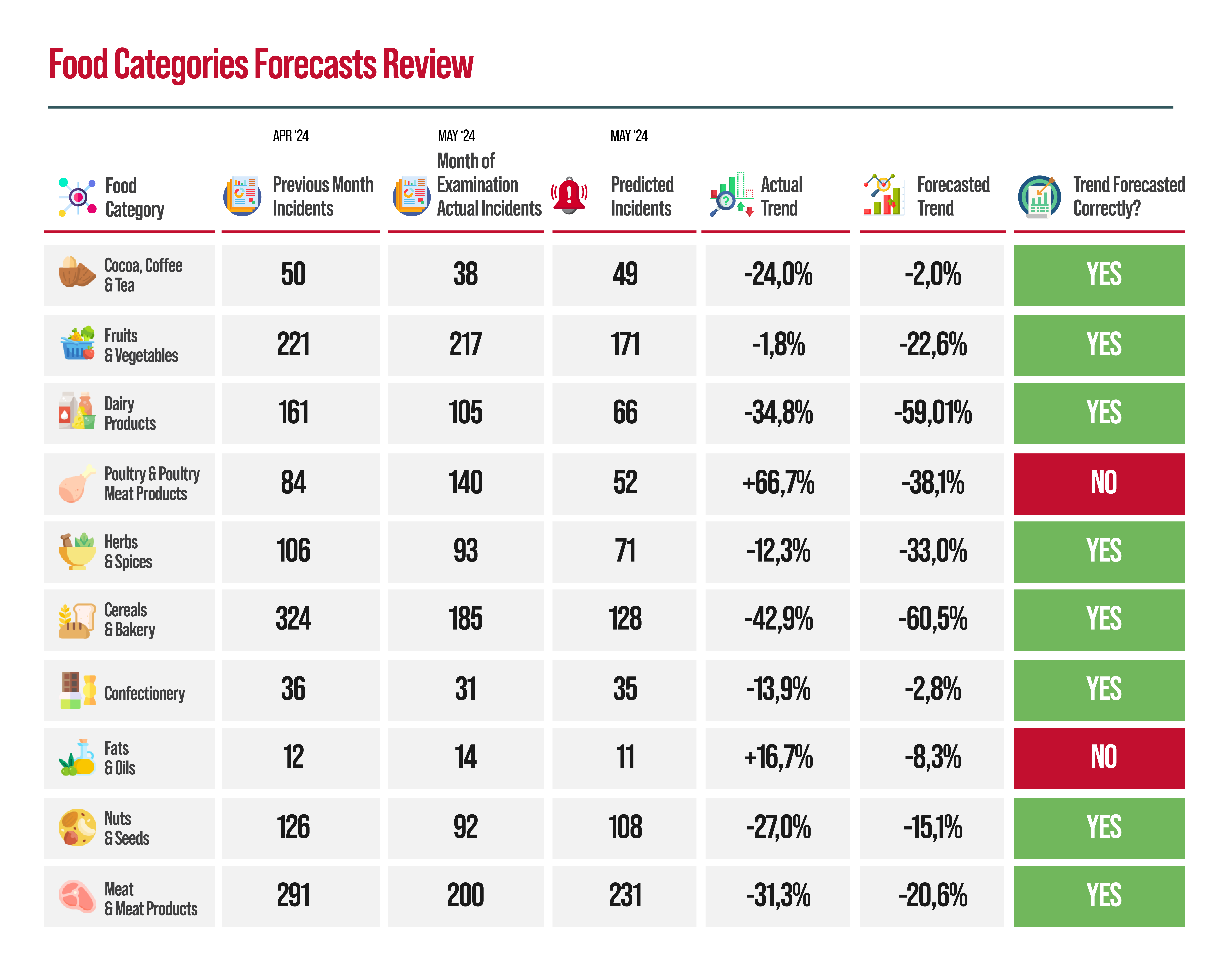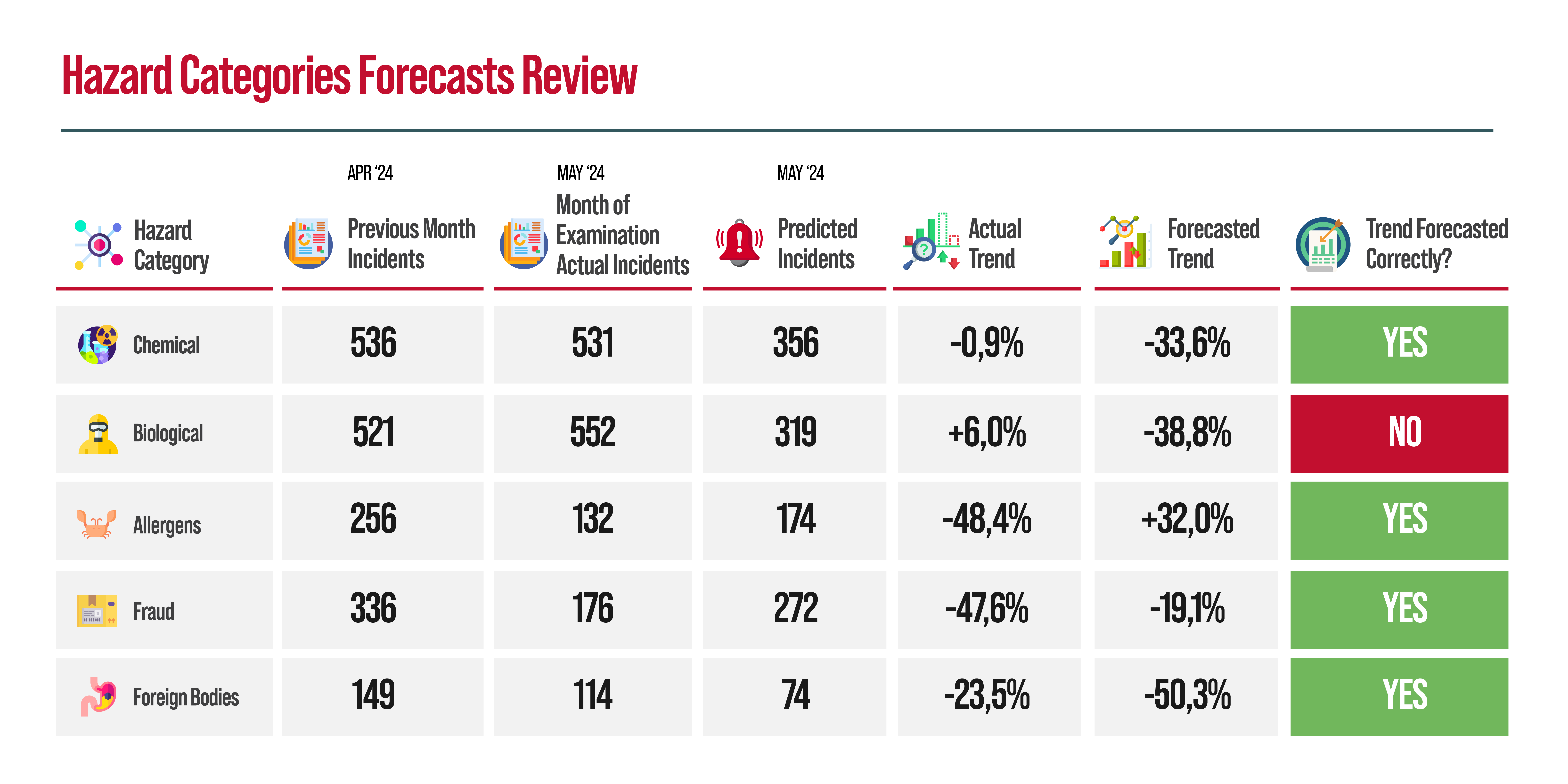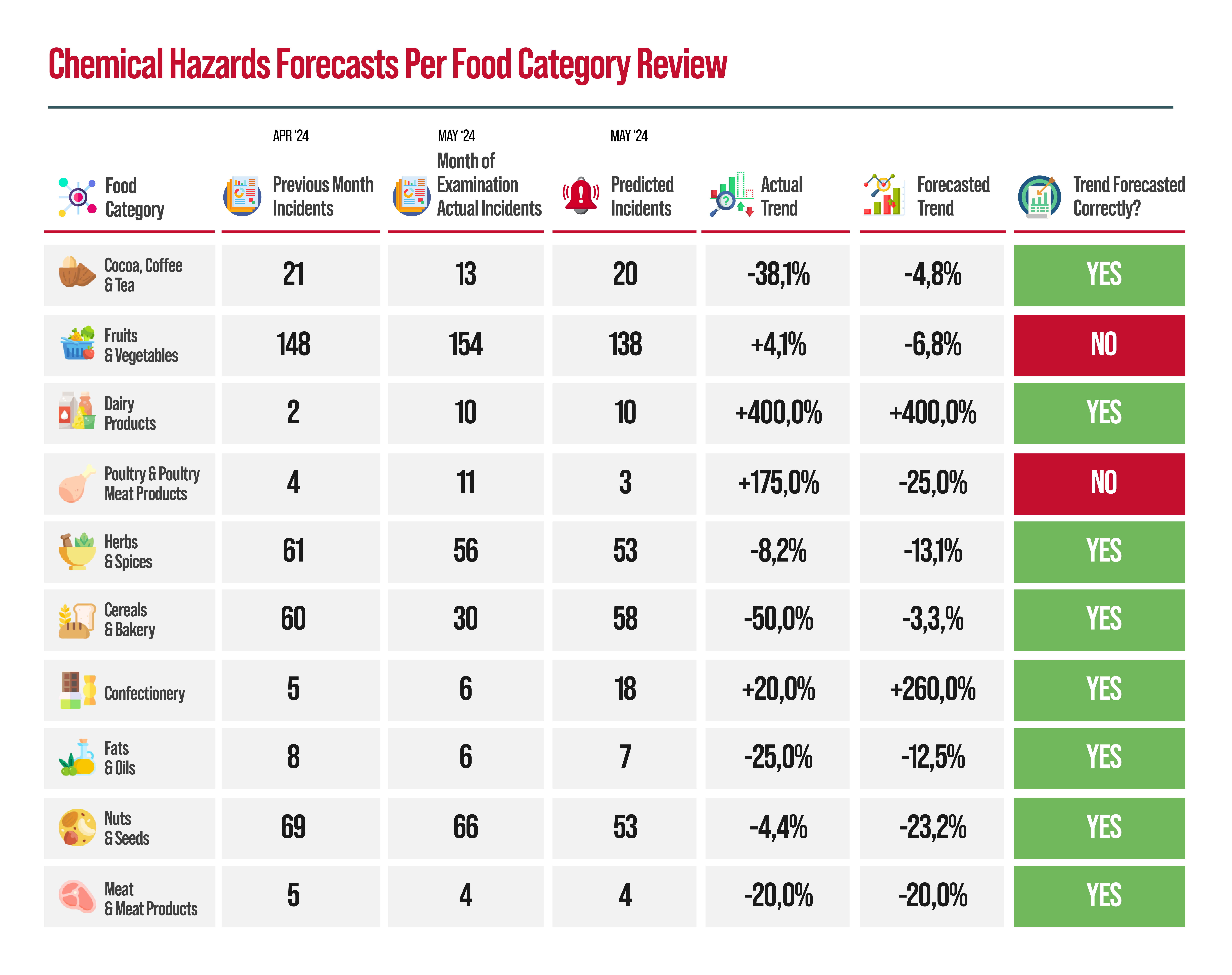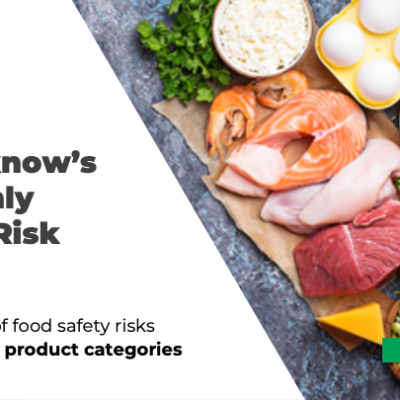
Monthly Forecasts Review: May
Welcome back to our Monthly Forecasts Review Series, where we review our monthly forecasting outcomes by examining the performance of our incidents forecast’s trends for the previous month, May.
More specifically, this includes forecasts for 10 key food categories as well as the hazard trends forecasts for the top Biological, Chemical, Foreign Bodies, Allergens Hazard Categories as well as Food Fraud. Moreover, we look closer at the Chemical Hazard Forecasts for these product categories.
How is the performance review conducted?
We compare the forecasted incidents trend for each food product category, hazard, and risk category from FOODAKAI, the AI-powered & predictive data analytics platform, versus the actual number of recorded incidents for that month.
New Forecasting Features
To date, the trend forecasting models utilized the available historical incidents to forecast future values. In order to enhance the forecasting capabilities of trend forecasting and improve the accuracy, we introduced more factors in the training process of the forecasts. More specifically, we now include lab test data (below-limit lab tests, above-limit lab tests, etc.), weather data (temperature, precipitation, humidity, etc.), and date (month of the incident, year of the incident, etc.) in parallel with the historical incidents. As a result, over the next weeks, we will be looking at more and more accurate and robust predictions that are not influenced only by historical incidents.
For our previous edition, read here.
Key Food Categories Forecasts Review
Firstly, let’s start with the overall incidents trend forecasts in 10 Key Food Categories for May.

FOODAKAI forecasted the incidents trend successfully in 8 out of the 10 key food categories: Cocoa, Coffee & Tea, Fruits & Vegetables, Dairy Products, Herbs & Spices, Cereals & Bakery, Confectionary, Nuts & Seeds and Meat & Meat Products. The forecasts for the Poultry & Poultry Meat Products and Fats & Oils products category were not successful.
Highlights:
- In the Cocoa, Coffee & Tea product category, FOODAKAI forecasted the decreasing trend, but anticipated a lower decrease in the number of incidents (-2.0%) than the actual (-24.0%).
- In the Fruits & Vegetables food category, the platform correctly anticipated the decreasing trend, however, a higher decrease (-22.6%) than the actual (-1.8%).
- In the Dairy products category, the platform correctly forecasted the decreasing trend, projecting, however, a higher decrease (-59,01%) than the actual (-34.08%).
- Unfortunately, for Poultry & Poultry Meat Products, while the platform forecasted a decrease of -38.10% there was an increase of 66.7% in the number of incidents. This can be attributed to a new algorithm that was introduced which could benefit from tuning the model for better forecast in the next month.
- For the Herbs & Spices product category, FOODAKAI forecasted a decreasing trend although anticipating a higher decrease than the actual as was also the case with Cereals & Bakery Products.
- FOODAKAI in the Confectionary, Nuts & Seeds and Meat & Meat Products food categories forecasted with great success the decreasing trends in all three product categories.
- In the Fats & Oils and Nuts & Seeds product categories, FOODAKAI didn’t anticipate the increasing trend but rather a decrease which due to minor difference in the actual number of incidents can be attributed to a statistical failure.
Hazard & Risk Categories Forecasts Review
Now, let’s review the performance of the hazard & risk trend forecasts in comparison to the recorded number of incidents.

FOODAKAI successfully forecasted the incidents trend in 4 out of the 5 Hazard and Risk types: Chemical, Allergens, Fraud and Foreign Bodies. It didn’t forecast the trend for Biological incidents.
Highlights:
- For Chemical Hazards incidents, the platform successfully forecasted the decrease in incidents trend, but the predicted value was bigger than the actual, which can be enhanced with a tuning for the model as the large volume of data permits a better forecasting.
- For Biological Hazard incidents, FOODAKAI failed to forecast the increase, predicting a decrease. As this hazard category contains a lot of data, a better prediction is possible and highlighting the need to revisit the timeseries in order to tune the model.
- In the Allergen Hazard type category, FOODAKAI forecasted with great success the decreasing trend.
- In the Food Fraud product category, the platform forecasted the decreasing trend correctly but a lower level of increase than the actual.
- In the Foreign Bodies Hazard type category,FOODAKAI successfully forecasted the decreasing trend, although anticipating a higher increase than the actual incidents.
Chemical Hazards Forecasts Per Food Category
Finally, let’s dig deeper into the forecasted vs the actual trends for incidents associated with chemical hazards for these 10 Food Categories.

The platform correctly forecasted the chemical hazard incidents in 8 out of the 10 food categories: Cocoa, Coffee & Tea, Dairy Products, Herbs & Spices, Cereals & Bakery, Confectionary, Fats & Oils, Nuts & Seeds and Meat & Meat products. For the Fruits & Vegetables Confectionary and Poultry & Poultry Meat Products categories the incident trend was not forecasted successfully.
Highlights:
- For Chemical Hazards in Cocoa, Coffee & Tea products, the platform forecasted a decreasing trend, although with a slight difference in the percentages.
- In the Fruits & Vegetables as well as Poultry & Poultry Meat Products categories, FOODAKAI didn’t forecast the increasing trend but rather anticipated an increase.
- For Chemical Hazards incidents Dairy products, a 100% accurate forecasting was achieved with the number of incidents forecasted to increase by 400%.
- In the Herbs & Spices product category, the decreasing trend was validated with only a minor difference in the number of incidents.
- In both Cereals & Bakery and Fats & Oils product categories, FOODAKAI forecasted the decreasing trend although with a slight difference between the actual and forecasted incidents.
- For Confectionary products, while FOODAKAI forecasted an increasing trend, it didn’t anticipate the level of increase which was much higher.
- In the Nuts & Seeds product category the platform managed to forecast a decreasing trend, although anticipating a higher decrease compared to the actual.
- Finally, for the Meat & Meat Products category, the platform achieved perfect forecasting, projecting and validating a 20.0% decrease.
To navigate the complexities of the food and beverage industry, companies can immensely benefit from integrating precise incident forecasts and trend analyses for each product or ingredient into their essential risk assessment procedures. This way they can create a strong risk mitigation strategy based on emerging and increasing risks. By proactively addressing potential problems, companies can avoid potential future recalls and incidents, ensuring product safety and maintaining consumer trust.
Want to learn more about how you can benefit from such forecasts, book a demo here.
Want to receive helpful food safety intelligence in your inbox?








